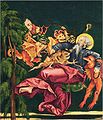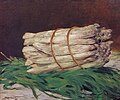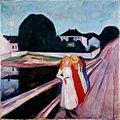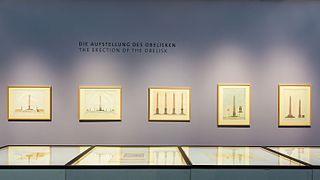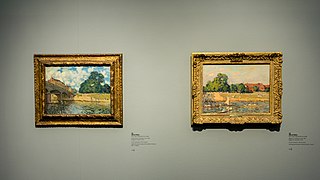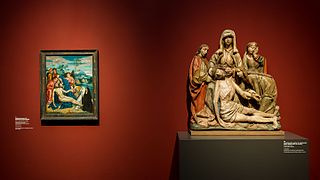Wallraf-Richartz-Museum & Fondation Corboud
 Front view of the Wallraf-Richartz-Museum & Foundation Corboud (2014) |
|
| Data | |
|---|---|
| place | Obenmarspforten 40 Am Kölner Rathaus 50667 Cologne , Germany |
| Art | |
| opening | July 1, 1861 |
| management | |
| Website | |
| ISIL | DE-MUS-079214 |
Wallraf-Richartz-Museum & Fondation Corboud in Cologne are one of the great classic picture galleries in Germany. The oldest museum in the city of Cologne houses the world's most extensive collection of medieval painting in a building dating from 2001 , especially the “ Cologne School of Painting ”, as well as a representative selection of art from the 16th to 19th centuries. With the works of the Fondation Corboud , the museum has the most extensive collection of impressionist and neo- impressionist art in Germany. The inventory also includes an important graphic collection of more than 75,000 sheets from the Middle Ages to the 20th century. Marcus Dekiert has been director of the museum since March 1, 2013 .
Museum history
Museum foundation and previous buildings
The Wallraf-Richartz-Museum of the City of Cologne has existed since 1824. Its collection history, however, can be traced back to the extensive bundle of the graphic collection of the former Cologne Jesuit Museum, which was added to the inventory in the 1880s Trace back to mid-16th century.
The reason for the founding of the oldest of the Cologne city museums was the testamentary decree of the Cologne canon and last rector of the old Cologne University Ferdinand Franz Wallraf (1748-1824). In his will of May 18, 1818, he bequeathed his extensive estate to the city of Cologne, which consisted primarily of secularization assets, “under the express, uncompromising condition that my collection of art, minerals, painting, copperplate engravings and books belong to eternal days this city and community for the benefit of art and science [...] should remain ”.
Wallrafianum in the Cologne Court (1827–1861)
On July 8, 1827, three years after the death of Ferdinand Franz Wallraf, part of the collection was made accessible to the public in the rooms of the former quarters of the Archbishops of Cologne , the then “ Kölner Hof ” at Trankgasse 7.
The city council appointed a friend of Wallraf, the merchant, painter and art collector Matthias Joseph de Noël (1782–1849), who managed the collection until 1842, as the first curator of the interim museum, soon to be known as the Wallrafianum . Soon after taking office on January 10, 1844, de Noël's successor, the painter Johann Anton Ramboux , pointed out the need for a new building.
Only when the Cologne merchant Johann Heinrich Richartz (1796–1861) agreed to donate 100,000 thalers for the construction of a new museum building in 1851 could the building project be tackled.
Ferdinand Franz Wallraf , art collector
Johann Heinrich Richartz , founder of the museum building
Matthias Joseph de Noël , first curator
Johann Anton Ramboux , second curator
Wallraf-Richartz-Museum (Felten-Raschdorff-Bau, 1861-1943)
According to the plans of Josef Feltens (1799–1880) with the collaboration of Julius Carl Raschdorff (1823–1914) and Friedrich August Stüler (1800–1865), the foundation stone was laid on October 4, 1855 in the presence of the Prussian King Friedrich Wilhelm IV Museum on the site of the former Minorite monastery (Kölner Hof). Including the cloister, the architects erected a building in the English-Neo-Gothic style , which was officially opened as the Wallraf-Richartz Museum on July 1, 1861 due to additional donations from Richartz (a total of 277,000 thalers). The city honored the collector and the founder with two statues of Wilhelm Albermann , which were unveiled on April 10, 1900 by Mayor Wilhelm von Becker .
The museum was reorganized in 1921 in connection with the Museum of Applied Arts . It was divided into an "old gallery" with Karl Schäfer, who had been director of the museum since 1920, as director, and a "gallery of the modern age" with Hans Friedrich Secker as director. However, the division proved to be a failure for organizational and personnel reasons. Mayor Konrad Adenauer advised the two directors to resign from their office. Seckers resigned on February 1, 1928, Schäfer was dismissed and put into temporary retirement. On October 1, 1928, Ernst Buchner became the new director of the reunified museum, and Ernst Holzinger was the responsible curator for the newer department . In 1933 Otto H. Förster became director. 1936–1937 the building was converted by the architect Heinrich Bartmann . From 1941 onwards, Förster sold a total of 630 works, which he labeled "inferior" or "worthless", including a large-format landscape by August Weber and a work by Max Liebermann . The proceeds were used to purchase works from dubious property from the occupied territories in the east.
During the "Peter and Paul Night" from June 28 to 29, 1943, the museum building was completely destroyed in an air raid.
Wallraf-Richartz-Museum (Schwarz-Bernhard-Bau, 1957–1986)
On May 27, 1957, after a construction period of four years, a new museum according to the plans of the architects Rudolf Schwarz and Josef Bernhard was opened on the old site, now with the address “An der Rechtschule” .
However, criticism of the room layout and insufficient capacity sparked the discussion about a larger new building in another location soon after the opening. With the takeover of the Peter Ludwigs collection in 1968, the considerations received an increased impetus. In October 1975 there was an invitation to tender for an ideas competition, in 1976 the award winner, the architecture firm Busmann + Haberer , and in 1977 construction work for a large new building on the site of the former bus station in the immediate vicinity of Cologne Cathedral.
The exhibition rooms of the Museum of Applied Art are located in the Schwarz-Bernhard-Bau from 1957 .
Wallraf-Richartz-Museum and Museum Ludwig (Busmann-Haberer-Bau, 1986-2001)
After a construction period of almost 10 years, the new building complex for the Wallraf-Richartz-Museum and the now founded Museum Ludwig as well as for the Cologne Philharmonic between the cathedral and the Rhine were opened on September 6, 1986 .
The acceptance of further art foundations by the couple Peter and Irene Ludwig in 1994 and the associated agreement between the donors and the Cologne City Council made it necessary to build an independent new building for the Wallraf Collection.
New museum building
Wallraf-Richartz-Museum & Fondation Corboud (Ungers-Bau, 2001)
At its meeting on October 26, 1995, the council decided to build its own new building for the Wallraf-Richartz-Museum in the city center near the town hall and the historic Gürzenich building. According to notes from the diary of the Cologne art collector Sulpiz Boisserée , the first museum building was to be built at this point near Stefan Lochner's former workshop . In May 1996, the design by Cologne architect Oswald Mathias Ungers emerged from the architectural competition as the winner of the 1st prize.
After laying the foundation stone in 1998, the new Wallraf-Richartz-Museum was opened on January 19, 2001.
The cubic building between the town hall and Alt St. Alban , designed by the architect Oswald Mathias Ungers , shows graphics and paintings from the Middle Ages to the 19th century on an exhibition area of 3500 square meters ; Another 800 square meters are available for special exhibitions . When the Swiss collector Gérard Corboud gave numerous Impressionist paintings on permanent loan in 2001 , the name of the museum was expanded to include the official Wallraf-Richartz-Museum & Fondation Corboud . Since September 2006 the museum has had the slogan: "Wallraf the Museum".
Panel paintings of medieval painting on the 1st floor
Wallraf-Richartz-Museum & Fondation Corboud (extension on the "Kaufhaus Kutz" site)
With the adoption of the Corboud Foundation (2001), the city council offered the patron the prospect of an expansion of the museum to present the works appropriately. On the occasion of the 150th anniversary of the museum on June 30, 2011, Lord Mayor Jürgen Roters renewed the commitment. In May 2012, the collector threatened to withdraw his perpetual loan because the expansion of the museum that had been promised to him had not yet been initiated. At its meeting on June 28, 2012, the council decided to entrust the administration with planning the expansion of the Wallraf-Richartz-Museum & Fondation Corboud. The winner of the architecture competition was presented on November 18, 2013. Since the construction of the extension has not yet started, Marisol Corboud, the widow of the collector Gérard Corboud, gave the city an ultimatum several times for him. In November 2018, in response to the delay, Marisol Corboud announced the withdrawal of 19 images from the “Fondation Surpierre” from the museum's depot. In November 2019, the city of Cologne announced that it would obtain a new council resolution on the extension by June 2020 in order to award the construction contract in 2021 and finally to start construction in 2022, 21 years after the first announcement. The Council of the City of Cologne passed the construction decision in June 2020. The schedule provides for construction to start in the second half of 2022 and the building to be commissioned in 2025.
Head of the museum
- Matthias Joseph de Noël (1828–1849)
- Johann Anton Ramboux (1844–1866)
- Carl Aldenhoven (1890–1907)
- Alfred Hagelstange (1908–1914)
- Karl Schaefer (1920–1928, older collection)
- Hans Friedrich Secker (1922–1928, "Gallery of Modern Times")
- Ernst Buchner (1928–1933)
- Otto H. Förster (1933–1945)
- Leopold Reidemeister (1950–1957)
- Otto H. Förster (1957–1960)
- Gert von der Osten (1960–1975)
- Gerhard Bott (1975–1980)
- Rainer Budde (1981-2004)
- Andreas Blühm (2005–2012)
- Marcus Dekiert (since 2013)
Gerhard Bott managed the house from 1975 to 1980 . Under his leadership, the Ludwig Collection was integrated on the one hand, and the Museum Ludwig was then founded in 1986 on the other. After Bott moved to Nuremberg as General Director of the Germanisches Nationalmuseum in 1980, Rainer Budde followed him from 1981 to 2004. Andreas Blühm was appointed as his successor in 2005 . His deputy was Roland Krischel .
On July 8, 2010, Blühm was awarded the first by the Cologne Cultural Council “for his artistic successes, his significance for Cologne culture and his special management skills, with which he made the museum one of the top addresses among German art museums” Cologne Culture Prize awarded as “Best Cultural Manager of the Year 2009”. Although the Cologne City Council extended his contract to June 30, 2015 in July 2010, it was announced in May 2012 that Blühm will be leaving the museum in September 2012 to take up the position of director of the Groninger Museum . The acting management of the house was taken over by Roland Krischel as deputy director.
A search committee headed by Georg Quander , the head of the cultural department , proposed Marcus Dekiert to the Cologne City Council to succeed Andreas Blühm; he took over the office of museum director on March 1, 2013.
Collections

Wallraf-Richartz-Museum & Fondation Corboud house one of the most important collections of medieval painting in the world. Such an extensive collection of medieval panel paintings has survived in no other city, as there were neither major city fires nor iconoclasms in Cologne . With works of the Baroque as well as paintings and sculptures from the 19th and 20th centuries, the museum shows a comprehensive overview of the history and development of art from the Middle Ages to the 20th century.
Art of the 13th to 16th centuries
The museum's founder, Ferdinand Franz Wallraf , collected the altarpieces of the profaned churches, monasteries and monasteries during the secularization . His collection is the basis of the museum's medieval section. Cologne painting can otherwise only be viewed in this extensive way in Munich ( Alte Pinakothek ), because that is where the collection of the Cologne brothers Sulpiz and Melchior Boisserée came . Works by Stefan Lochner as well as works by the following masters: Master of Saint Veronica , Master of St. Laurenz , Master of the Legend of St. George , Master of the Bartholomew Altar , Master of the Glorification of Mary , Master of St. Severin , Master of the Legend of Ursula and many other painters from Cologne Painting schools can be found in the collection.
Master of St. Veronica ,
The Little Calvary, around 1400Stefan Lochner ,
The Last Judgment, around 1435Albrecht Dürer ,
Piper and Drummer, around 1503
17th to 18th century art
The baroque department shows a very good cross-section of art production since around 1550. One focus of the structure of the collection is painting in the northern Netherlands. Main works are represented by Rembrandt , Maarten van Heemskerck , Gerrit van Honthorst , Jan Victors , François Boucher , Paris Bordone , Peter Paul Rubens and Anthonis van Dyck .
Peter Paul Rubens ,
Juno and Argus , around 1610Peter Paul Rubens ,
The miraculous fish haul, around 1610Jacob Jordaens ,
Prometheus bound , around 1640Rembrandt ,
self-portrait, around 1668François Boucher ,
Girl at Rest ( Marie-Louise O'Murphy ), 1751
19th to 20th century art
In the 19th century department, good examples illustrate the development of art in the 19th century. From the German-Romans of the late 18th century ( Jakob Philipp Hackert , Johann Christian Reinhart , Joseph Anton Koch ) the arch spans the German early and late Romanticism ( Caspar David Friedrich , Carl Blechen , Gerhard von Kügelgen ) to the Nazarenes ( Eduard Bendemann , Julius Schnorr von Carolsfeld ). This is followed by an extensive collection by the Cologne painter Wilhelm Leibl . In addition, the museum shows works by Gustave Courbet , Max Liebermann and paintings and sculptures of Symbolism : Arnold Böcklin , Franz von Stuck , Marianne Stokes , James Ensor , Edvard Munch , as well as noteworthy sculptures and others. a. by Jean-Antoine Houdon , Rudolf Schadow , Pierre-Auguste Renoir , Auguste Rodin .
Pierre-Auguste Renoir ,
The Couple (Les fiancés), around 1868Édouard Manet ,
Bundles of Asparagus , 1880Max Liebermann ,
The Bleached Lawn, 1882Vincent van Gogh ,
The Bridge at Arles , 1888Edvard Munch ,
Four Girls on the Bridge , 1905
The affiliated Fondation Corboud shows the most extensive collection of paintings from French and international Impressionism and Late Impressionism in Germany. Due to the lack of exhibition space, a large part of this collection has so far been stored in the depot. The extension building promised by the city of Cologne since 2001 to present the collection has not yet been completed.
Gustave Courbet ,
Chillon Castle, 1873Édouard Manet ,
Fishing Boat on the Beach at Berck, 1873Berthe Morisot ,
Child between Hollyhocks, 1881Paul Signac ,
Capo di Noli, 1898Gustave Caillebotte ,
Plain of Genievilliers, 1884
Graphic collection
The holdings of the Graphics Collection include around 75,000 works of art on paper, including exquisite miniatures on parchment, unique hand drawings and paintings on paper and cardboard, a number of sketchbooks and numerous important prints in a variety of different techniques. They cover the period from the Middle Ages to the 20th century. These include artists such as Leonardo da Vinci , Raffael , Albrecht Dürer , Luca Cambiaso , Hendrick Goltzius , Rembrandt van Rijn , Caspar David Friedrich , Philipp Otto Runge , Karl Friedrich Schinkel , Carl Spitzweg , Anselm Feuerbach , Edvard Munch , Max Liebermann , Lovis Corinth and Auguste Rodin . The estate of the architect Jakob Ignaz Hittorff deserves special mention , a bundle of approx. 7,500 pieces, which offers a panorama of international antiquity research, architecture and urban design of the 19th century and groups of works by Hittorff and other artists such as Louis-François Cassas or Jean -Baptiste Lepère contains. In the graphic cabinet of the museum, smaller exhibitions on changing themes from the thematic area of art on paper (hand drawings and prints) are regularly held under the series title “The un-certain view”. Since March 1, 2019, the director of the graphic collection has been the art historian Anne Buschhoff, succeeding Thomas Ketelsen.
England, around 1100,
Disputatio des Anselm von Canterbury ,
pen in brown ink and body color, on parchment, around 1100Rembrandt ,
The Three Crosses ,
etching, 1653Philipp Otto Runge ,
The Genii on the Light Lily,
pencil, black, red and white chalk, on brownish paper, 1809Vincenz Statz ,
"And he'll be done!", Vision of the cathedral towers,
watercolor on paper, 1861
Board of Trustees Wallraf-Richartz-Museum and Museum Ludwig e. V.
The association Kuratorium Wallraf-Richartz-Museum und Museum Ludwig , 1959 as Wallraf-Richartz-Kuratorium und Förderergesellschaft e. V. founded , forms the joint support association for both art museums, in which art-interested citizens from home and abroad are represented and exclusively and directly pursues charitable purposes. The important tasks include the purchase of important exhibits to complete the collection and the expansion of the museums. In the last 50 years (up to 2012), 46 important works have been purchased, including Marc Chagall's Moses Smashing the Tablets of the Law (1955/56), acquired in 1960; Édouard Manet's Asparagus Still Life (1880), acquired in 1968, or Claude Monet's Water Lilies (1915–1917), acquired in 1980.
Special exhibitions
Special exhibitions 2017/2018/2019
- Cupid is eternal - love reading for Rubens' time , February 14th - May 24th, 2020.
- Inside Rembrandt • 1606–1669 , November 1, 2019 - March 1, 2020 (in cooperation with the National Gallery in Prague ).
- Rembrandt's graphic world . Experiment. Competition. Virtuosity, October 3, 2019 - January 12, 2020.
- We believe art. Master drawings from the Jesuit collection in Cologne , May 24 - August 18, 2019.
- The wolf between myth and fairy tale , February 1 - April 28, 2019.
- Once Upon a Time in America. 300 Years of American Art , November 23, 2018 - March 24, 2019.
- in the Graphisches Kabinett: Shadows in View , September 28, 2018 - January 13, 2019.
- Rubens & Co. master drawing from Flanders , June 15 - September 9, 2018.
- Wallraf's legacy. A citizen saves Cologne , March 23 - July 8, 2018.
- The letter and the drawing , February 23 to May 21, 2018.
- Wonderful. Honthorst's Adoration of the Shepherds , November 17, 2017 to February 4, 2018.
- Tintoretto - A star was born , October 6, 2017 to January 28, 2018.
- Clear to cloudy. Natural spectacles in Dutch painting , June 1, 2017 to February 4, 2018.
- A graphic revolution. The Italian color woodcut of the 16th century , September 22nd 2017 to January 14th 2018.
- 1917 - In memory of Luise Straus-Ernst . The reconstruction of their war exhibition in the Wallraf. With a reflection by Louisa Clement , 23 June to 10 September 2017.
- Paris awakes! - Hittorff's invention of the Place de la Concorde , April 7th to July 9th, 2017.
2016
|
|
2015
|
|
2014
|
|
2013
|
2012
|
2011
|
2010
|
2009
|
Movies
- Museum check with Markus Brock : Wallraf-Richartz-Museum Cologne and Max Ernst Museum Brühl. Synopsis and video from 3sat. First broadcast: January 13, 2019
literature
History of the museum
- Joachim Deeters (Ed.): Franz Ferdinand Wallraf. Exhibition of the historical archive of the city of Cologne; Dec. 5, 1974-31. Jan. 1975. Historical Archives of the City of Cologne, Cologne 1974.
- Maria Heer: An art museum is the city's conscience. From the Wallrafianum to the building by Oswald Mathias Ungers: the Wallraf-Richartz-Museum in Cologne has its own home. In: Neues Rheinland , Volume 44, 2001, Issue 1, pp. 10-11.
- Andreas Blühm (Ed.): 150 Years Wallraf-Richartz-Museum. Festschrift for the 150th anniversary of the opening of the first Wallraf-Richartz Museum in Cologne on July 1, 1861 . JP Bachem Verlag, Cologne 2011, ISBN 978-3-7616-2481-4 .
Collection catalogs and other publications on the collection holdings
- Christian Hesse, Martina Schlagenhaufer (eds.): Wallraf-Richartz-Museum Cologne. Complete directory of the painting collection . 2 volumes, DuMont, Cologne 1986, ISBN 3-7701-1979-7 .
- Rainer Budde, Roland Krischel, Thomas Blisniewski , Eva Hartmann: The Wallraf-Richartz-Museum. Hundreds of masterpieces from Simone Martini to Edvard Munch . Dumont, Cologne 2001, ISBN 3-7701-5618-8 .
- Martin Oehlen, Stefan Worring (photographer): Museums in Cologne. DuMont, Cologne 2004, ISBN 978-3-8321-7412-5 .
- Stephanie Sonntag, Andreas Blühm (Ed.): Picture stories. Masterpieces from the Wallraf-Richartz-Museum. Dumont, Cologne 2008, ISBN 978-3-8321-9139-9 .
- Thesy Teplitzky: Cologne Portraits from the Late Middle Ages to Romanticism , Greven, Cologne 2015, ISBN / 978-3-7743-0659-2.
Web links
- Official website of the museum
- Wallraf-Richartz-Museum & Fondation Corboud . In: MuseenKoeln.de
- Wallraf-Richartz-Museum & Fondation Corboud . In: Koeln.de
- Website of the Friends of the Wallraf-Richartz-Museum and the Museum Ludwig eV
Individual evidence
- ↑ Quoted from: Exhibition catalog Franz Ferdinand Wallraf , Historical Archive of the City of Cologne, Cologne 1974/75, p. 92 cat. No. 147.
- ^ The Wallraf-Richartz-Museum . Dumont, Cologne 2001, ISBN 3-7701-5618-8 , pp. 15-16.
- ^ Daniela Wilmes: Private collecting with calculation. Aspects of Josef Haubrich's collecting activities during National Socialism . In: Ute Haug, Maike Steinkamp (ed.): Works and values. About trading and collecting art under National Socialism . Akademie-Verlag, Berlin 2010, ISBN 978-3-05-004497-2 , p. 161.
- ^ T. Nagel: Museum in Flames. Picture from the 25th week - 23rd to 30th June 2003. In: Museenkoeln.de .
- ^ Mathias Schreiber: The third way, Wallraf-Richartz-Museum Cologne . In: Mathias Schreiber: German Architecture after 1945, 40 Years of Modernism in the Federal Republic , Stuttgart 1986, p. 36.
- ^ Ceremony in the Wallraf-Richartz-Museum at www.ksta.de on June 30, 2012, accessed on July 6, 2012.
- ↑ Founder Corboud wants to pull collection on www.rundschau-online.de from May 22, 2012, accessed on July 6, 2012.
- ↑ Resolution draft at http://ratsinformation.stadt-koeln.de , accessed on July 6, 2012.
- ↑ The winners of the architecture competition have been determined , accessed on February 12, 2014.
- ↑ Martin Oehlen: "That's a joke": Corboud gives the city of Cologne a new ultimatum for Wallraf expansion. In: Kölner Stadt-Anzeiger. Retrieved November 24, 2018 .
- ^ Wallraf-Richartz-Museum: Marisol Corboud announces the withdrawal of 19 pictures from Cologne. Kölnische Rundschau, accessed on November 24, 2018 .
- ↑ Schedule: This is how the expansion of the Wallraf-Richartz Museum in Cologne works. In: Kölner Stadt-Anzeiger. November 21, 2019, accessed November 27, 2019 .
- ↑ Jürgen Müllenberg: Council takes building decision for the museum extension and the perimeter block development. City of Cologne - Office for Press and Public Relations, June 19, 2020, accessed on June 19, 2020 .
- ↑ Kölnische Rundschau: A lush consolation with Monet's "Water Lilies" from December 20, 2004.
- ↑ Current information on www.koelnerkulturrat.de.
- ↑ Interview in Andreas Blühm on www.ksta.de.
- ↑ Dr. Marcus Dekiert is to head the Wallraf-Richartz-Museum. Head of Culture Professor Quander introduces the designated director . Press release from the Office for Press and Public Relations of the City of Cologne, October 18, 2012, accessed on October 18, 2012; Kölner Stadtanzeiger from October 18, 2012: Marcus Dekiert becomes WRM Director .
- ^ Corboud to the Wallraf Richartz Museum. In: Kölner Stadt-Anzeiger. Retrieved November 26, 2018 .
- ↑ City of Cologne press releases from March 11, 2019 , accessed on March 11, 2019.
- ^ Wallraf-Richartz-Museums & Fondation Corboud , accessed on August 19, 2014.
- ^ Frankfurter Allgemeine Feuilleton from October 10, 2017: Tintoretto's early work in Cologne. Everything in motion , by Andreas Platthaus , accessed on October 11, 2017.
Coordinates: 50 ° 56 ′ 14.8 " N , 6 ° 57 ′ 30.6" E















